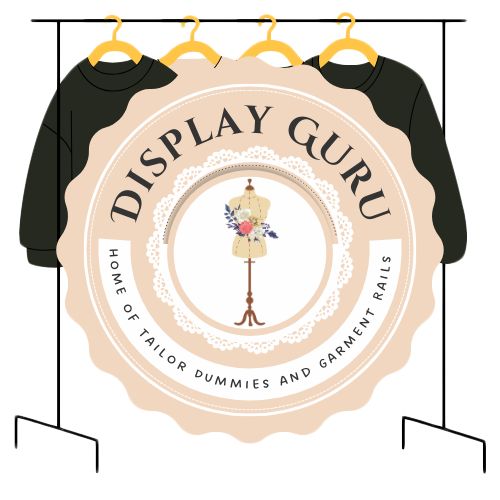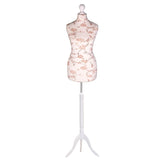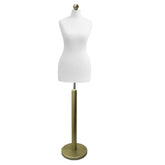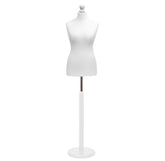A Professional Guide to Costume Rails
In a bustling theatre, a hectic film set, or a busy retail stockroom, the line between seamless organisation and complete chaos often comes down to a simple metal frame. Professional costume rails are the unsung heroes of these demanding places, giving you the strength, mobility, and sheer reliability that your average domestic clothing rack just can't offer. They aren't just for storage; they are mission-critical tools that drive efficiency.
Why Professional Costume Rails Are a Must-Have
Picture the frantic energy backstage during a lightning-fast costume change. Actors are rushing, dressers are moving with focused precision, and every single second counts. In this high-stakes world, a flimsy clothes rail from a high street shop would buckle under the pressure—both literally and figuratively. Professional costume rails, on the other hand, are engineered for exactly this kind of intense, non-stop use.
This is where the difference becomes incredibly clear. A standard rail you'd pick up for your bedroom is made for holding a few everyday items. A professional rail is built for a life of action.
Superior Build Quality and Durability
The real distinction is in the materials and construction. Proper, professional-grade costume rails are almost always forged from heavy-gauge steel or industrial-strength aluminium. This robust build means they can handle a huge amount of weight without bowing, bending, or breaking.
A typical professional rail can support over 100kg of garments, easily holding heavy period costumes, bulky winter coats, or an entire collection of retail stock. This capacity is vital for protecting valuable wardrobe investments from damage.
This level of durability means they can easily withstand the daily grind of being moved, assembled, and taken apart again and again—a common routine for touring theatre productions or pop-up shops.
Designed for Constant Mobility
Another key feature that sets the pros apart from the amateurs is mobility. They come fitted with industrial-grade castors (wheels) designed to glide smoothly across all sorts of floors, from polished concrete to thick carpet. These castors nearly always include sturdy locking mechanisms to keep the rail firmly and safely in place when you need it to stay put.
This on-the-go design is crucial for:
- Rapid Set Changes: Letting wardrobe teams wheel entire sets of costumes from one side of the stage to the other in seconds.
- Retail Efficiency: Helping staff move stock effortlessly from the storeroom to the shop floor.
- On-Location Shoots: Giving film and photography crews a portable wardrobe solution that can go anywhere.
Ultimately, putting your money into a high-quality, professional frame is a smart, practical move. For anyone managing a large volume of clothing in a fast-paced environment, a well-built steel garment rail is an indispensable asset for keeping things orderly, safe, and running smoothly.
The Evolution of Backstage Wardrobe Management

The story of the humble costume rail is, in many ways, the story of performance itself. If you could peek behind the curtains of early UK theatre, you’d find a scene of organised chaos. Backstage areas were often tight, cluttered spaces where costumes were slung over chairs or hung from a few simple hooks on the wall. For smaller shows with just a handful of wardrobe changes, this worked just fine.
But British entertainment was destined for bigger things. As the West End entered its golden age and film studios began to flourish, the sheer scale of productions exploded. Casts grew larger, storylines became more elaborate, and the demand for rapid-fire costume changes became critical. The old ways just couldn't cope.
From Static Hooks to Mobile Solutions
The move from basic hooks to mobile garment rails wasn’t a whim; it was a necessity. Wardrobe departments were suddenly tasked with managing, moving, and meticulously organising vast collections of costumes. They needed a system that was as dynamic as the performances themselves. A few hooks on a wall were no match for a sprawling film shoot or a multi-act play with dozens of outfits.
This is where metal clothing racks entered the scene, a practical solution to a pressing problem. These racks, which could be wheeled from dressing rooms right to the wings, completely changed the game. What was once a source of backstage panic became a smoothly choreographed operation.
The costume rail evolved from a simple piece of storage into an essential piece of backstage machinery. It became an active, silent participant in the performance, ensuring the magic on stage never missed a beat.
The post-war boom in British theatre really cemented the rail's importance. With productions thriving, the need for professional-grade equipment skyrocketed. If you look through old theatrical supply catalogues from that era, you can see a huge jump in the sale of metal costume rails. Some estimates suggest a 30-40% annual increase in wardrobe supplies during the busiest seasons.
Modern Rails for Modern Demands
Today’s costume rails are the refined descendants of those early workhorses. They aren’t just simple frames anymore; they are sophisticated tools engineered for specific, high-pressure environments. Features we now take for granted—like heavy-duty castors, collapsible frames, and adjustable heights—are all direct results of decades of hands-on experience in the wings and on set.
This evolution mirrors the journey of the industry. The need for stronger materials grew alongside the use of heavier, more intricate costumes in period dramas. The demand for portability coincided with the rise of touring productions and on-location filming.
A product like a robust, heavy-duty 5ft steel garment rail is a perfect example. It's the modern incarnation of the racks that once served the West End, now perfected for today’s standards of durability and capacity. When you understand this history, you really start to appreciate the thought and experience that goes into their design.
How to Choose the Right Costume Rail for Your Needs
Picking out the right costume rail is a bit like choosing the right tool for a job. You wouldn't use a tack hammer to drive a railway spike, and that flimsy rail from your spare bedroom simply won't cut it in a professional setting. The secret is to match the rail's design, material, and size to your specific needs, whether it's for a chaotic backstage area, a busy stockroom, or a film set.
Making a smart decision starts with knowing the fundamental types on the market. Each one is built with a different purpose in mind, and a quick look at your daily workflow will point you in the right direction, helping you stay organised and efficient.
This image really captures how a well-chosen rail system can bring order to chaos, making every garment easy to see and access.

As the picture shows, the ability to "Organise Easily" is the core benefit of a professional rail—a non-negotiable in any fast-moving production or retail environment.
Comparing Common Rail Types
First up is the single rail. This is your classic, straightforward workhorse, prized for its simplicity and strength. It’s perfect for hanging longer items like full-length gowns, heavy coats, or flowing robes, ensuring they don’t end up crumpled on the floor or snagged on a lower bar.
Then you have the double rail, a design that instantly doubles your hanging space without demanding much more of your floor plan. These are fantastic for separating costume elements, like keeping shirts on the top tier and trousers or skirts on the bottom. To see how this works in practice, this heavy-duty 2-tier double garment rail is a great example of maximising vertical storage.
A word of caution with double rails: always check the clearance. Make sure there’s enough height between the two bars for the garments you plan to hang on the bottom level, otherwise you’ll just be creating a new way to crease everything.
Z-base rails are another key player. You'll recognise them by their distinctive Z-shaped base, an engineering feature that delivers incredible stability. The real genius, though, is that they can be nested together for incredibly compact storage. This makes them a favourite for venues and hire companies that need to store dozens of rails when they’re not in use.
Finally, we have collapsible rails. These are the champions of portability. Designed to be broken down and reassembled in minutes, they are an absolute necessity for touring productions, on-location stylists, and pop-up shops.
Choosing the Right Material
A rail’s material is what determines its strength, lifespan, and overall look. It's not just about capacity; it's about finding the right balance for your environment.
To make this easier, here’s a quick comparison of the most common materials you’ll encounter:
Costume Rail Material Comparison
| Material | Key Features | Best For | Average Price Range |
|---|---|---|---|
| Heavy-Duty Steel | Exceptional strength and durability. Often powder-coated to resist scratches and rust. Very high load capacity. | Busy backstage areas, warehouses, stockrooms, and any environment where strength is paramount. | £50 - £150+ |
| Lightweight Aluminium | Significantly lighter than steel, making it easy to transport. Good strength-to-weight ratio. | On-location shoots, touring productions, freelance stylists, and mobile retail setups. | £40 - £120 |
| Sleek Chrome | Polished, professional finish. Good durability with a more aesthetic appeal. Resists tarnishing. | Retail showrooms, front-of-house displays, boutiques, and wardrobe departments where appearance matters. | £60 - £200+ |
Ultimately, the best material comes down to your priorities. Heavy-duty steel is the undisputed king for sheer strength, while aluminium is the go-to for anyone on the move. For a more polished look in a customer-facing space, chrome provides a perfect blend of style and substance.
By thinking carefully about both the type of rail and its material, you can find a solution that doesn't just hold your costumes, but actively improves your entire workflow.
Getting the Right Size and Capacity for Your Wardrobe
Picking the right costume rail isn't just about what fits in the room; it's about safety, organisation, and protecting your garments. Overload a rail, and you're asking for trouble. It's a classic rookie mistake that can lead to bent frames, a sudden collapse, and a pile of potentially damaged costumes on the floor. The trick is to know what you need before you buy.
Think of it like loading a removal van. You wouldn't just keep throwing boxes in without considering the weight limit. A rail's weight capacity is its most critical feature. A collection of heavy, layered period costumes puts a huge amount of stress on a frame, far more than a few lightweight modern dresses ever will.
Figuring Out Your Requirements
Before you even look at a rail, you need to have a rough idea of the total weight of the costumes you plan to hang on it. A heavy wool greatcoat could easily weigh 2-3 kilograms, whereas a delicate silk blouse is practically weightless in comparison. Do a quick tally of the estimated weight for everything destined for a single rail, and then add a bit extra.
A good rule of thumb is to choose a rail with a maximum capacity that’s at least 20-30% higher than what you think you need. This gives you a vital safety buffer, stops the rail from bowing over time, and leaves room for any new additions to the collection.
This simple bit of maths is your best defence against a wardrobe disaster, keeping your inventory and your team safe.
Choosing the Right Dimensions
Beyond just weight, the physical size of the rail is just as important. The length and height of the rail will dictate how organised and accessible your wardrobe truly is. Longer rails obviously offer more hanging space, but they also take up a bigger footprint and can be a nightmare to manoeuvre through narrow backstage corridors.
Recent feedback from UK theatre costume departments shows a clear trend. In one survey, a massive 89% of respondents confirmed they use mobile costume rails as their go-to storage solution. Within that group, 65% preferred rails between 100cm and 150cm long, with an adjustable height ranging from 120cm to 170cm. This sweet spot strikes a great balance between capacity and mobility, handling typical loads of 25kg to 40kg while being versatile enough for everything from long coats to short jackets. Understanding these industry standards can make a real difference, with some large productions reporting changeover times cut by up to 20%. You can learn more about the logistics behind theatre operations on news.market.us.
Here's a quick guide to help you decide:
- Rail Length: As a starting point, allow about 2.5cm of rail space for a standard garment on a hanger. For puffier items like winter coats or layered costumes, double that to 5cm per item.
- Adjustable Height: For any professional setup, this is non-negotiable. Being able to raise the bar for long gowns or lower it for jackets and shirts is essential. It stops hems from dragging on the floor and makes everything much easier to see and grab.
By taking the time to match the rail's size and capacity to your specific wardrobe, you're setting yourself up for a safer, more efficient, and far more organised space. It’s a thoughtful approach that makes your equipment a genuine asset.
Assembly and Maintenance for Lasting Performance

When you invest in a professional costume rail, you’re not just buying a piece of equipment; you're investing in your organisation's efficiency and safety. To get the best return on that investment, proper assembly and a little bit of routine care are crucial.
Thankfully, most quality costume rails are designed to be put together without any fuss. The click-in systems are a dream – the posts simply slot and lock into the base, and you pop the top bar on to complete the frame. All done in minutes, no tools needed. Even the heavy-duty bolted models only require a basic spanner to make sure every connection is rock-solid.
Key Assembly Tip: Always build your rail on a level surface. It might seem obvious, but starting on an uneven floor can twist the frame from the get-go, leading to an unbalanced structure before you've even hung a single costume.
Once it's built, a little proactive maintenance will keep your rail in prime condition for years to come. This isn't about spending hours on upkeep, but about simple checks that prevent bigger problems down the line.
Your Quick Maintenance Checklist
A quick, regular once-over can stop most common issues like wobbles or jammed wheels in their tracks. I’d suggest running through this list every couple of months, or more often if your rails are constantly on the move or bearing heavy loads.
- Tighten All Connections: Movement and vibrations can slowly loosen bolts and screws. Give them a quick check and tighten where needed to restore the rail’s stability.
- Inspect the Frame: Have a good look for any signs of bending or stress, especially where the parts join and along the main hanging bar. This is vital if you’re hanging particularly heavy costumes.
- Clean the Castors: Wheels are magnets for hair, dust, and stray threads. A quick clear-out keeps them rolling smoothly and prevents them from getting stuck at a critical moment.
- Check the Locks: Test the locking mechanism on each castor. Make sure it engages firmly. A rail that won’t stay put when you need it to is a genuine hazard.
Quick Fixes for Common Problems
Even the sturdiest rails can hit a snag. If your rail starts to feel wobbly, the first thing to check is that all the bolts are tight and the floor is level. If the wheels are stiff or squeaky, a quick spray of a silicone-based lubricant usually does the trick.
Sometimes, the issue isn't the rail itself but the demand you're placing on it. If you find you're consistently overloading a single rail, consider a more robust solution. A heavy-duty 2-tier double garment rail can be a fantastic way to spread the weight and double your storage without taking up much more floor space.
By making these simple assembly and maintenance steps part of your routine, you’ll ensure your costume rails remain dependable, long-lasting assets to your operation.
A Look at the UK Market for Costume Rails
It’s easy to think of a costume rail as just a piece of backstage furniture. In reality, they're a surprisingly accurate barometer of the UK's creative economy. The demand for these sturdy frames tells a fascinating story about the health and activity bubbling away in our theatres, film studios, and even high-street shops. Think of them as foundational tools; when sales are up, it’s a sign that industries are investing and growing.
When a West End theatre gets a major facelift or a new production hub for a streaming giant pops up, they need a mountain of reliable gear. Alongside the high-tech lighting rigs and sound systems, you’ll find a very practical, very necessary order for hundreds of costume rails. It's a fundamental purchase that signals a much deeper investment in getting a production off the ground.
A Growing Demand
You can see this link between equipment and industry health reflected in recent spending. In 2023 alone, the UK market saw an estimated £8 million expenditure on costume rails and similar garment storage. This represents a solid 7% year-on-year growth, a figure driven by theatre upgrades, the boom in TV production spaces, and a general move towards more modern, mobile rails. For a deeper dive, you can explore some of the broader UK market trends on sphericalinsights.com.
What this growth really shows is a shift in mindset. Industries are ditching flimsy, makeshift solutions and putting their money into equipment that’s built to last and designed to make life easier.
What Are People Buying?
When you look at purchasing habits, a clear pattern emerges. For professional use, the sweet spot is rails priced between £50 and £300. Models in this bracket, like a proper heavy-duty 6ft steel garment rail, deliver the strength and capacity needed for a demanding environment without breaking the bank.
On average, a professional costume department will buy between 5 and 10 new units every year. This isn't just about expanding for bigger shows; it's a constant cycle of replacing older, worn-out stock to keep things running smoothly.
At the end of the day, the market for something as simple as a costume rail gives you a brilliant, ground-level view of the money moving through the creative sector. Every rail bought is a small vote of confidence, making these metal frames a surprisingly insightful measure of the entire industry.
Your Costume Rail Questions, Answered
To help you get the most out of your equipment, let's tackle some of the most common questions we hear about professional costume rails. Think of this as your quick-start guide to solving frequent challenges and making the right choices from day one.
Key Differences and Capacities
What really separates a professional rail from a domestic one?
The biggest difference boils down to two things: durability and load capacity. A professional costume rail is a true workhorse, built from heavy-gauge steel or tough aluminium to support serious weight—often well over 100kg. They're engineered for the hustle of a busy theatre or a packed stockroom, complete with industrial-grade castors that make moving them a breeze.
Domestic rails, on the other hand, are designed for much lighter, static use at home and simply can't handle the same level of stress.
How do I figure out the weight capacity I actually need?
Start by estimating the average weight of your garments. A heavy wool coat could be 2-3kg, whereas a simple shirt is probably less than 0.5kg. Tally up the estimated weight for everything you intend to hang on a single rail to get a baseline figure.
Here's a pro tip: always choose a rail with a maximum capacity that’s at least 20-30% higher than your estimate. This gives you a crucial safety margin, preventing the rail from bowing and protecting your valuable costumes from a disastrous collapse.
Can I take these rails outside for an event?
Absolutely, but you need to pick the right one for the job. If you're heading outdoors, look for a rail made from a rust-resistant material like stainless steel or one with a protective powder-coated finish. It’s also vital to ensure it has large, heavy-duty castors that can roll smoothly and safely over uneven ground.
At Display Guru, we specialise in high-quality, durable rails designed specifically for demanding professional environments. You can explore our full range of costume rails to find the perfect solution for your needs.








